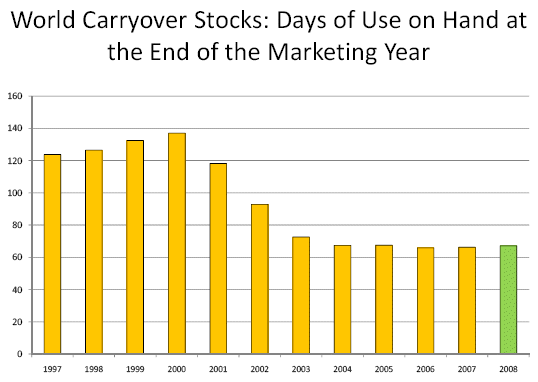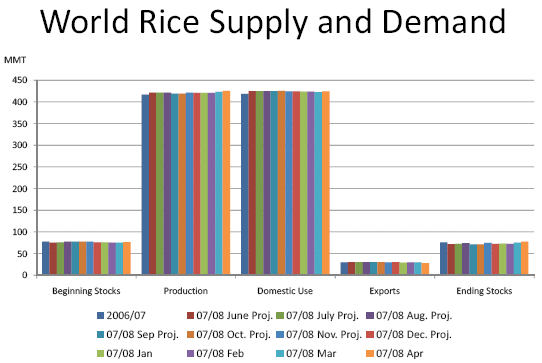April 24, 2008
Rice markets have been roiled by reports of trade restrictions by large rice exporting countries India, Vietnam, and Brazil and reports of rice rationing in the U.S. by major food retailers Sam’s Club and Costco. Such actions beg the question: Are we running out of rice?
The answer is no. Rice supplies are at relatively low levels, but the surge of panic buying and rapidly escalating prices is not supported by supply and demand fundamentals.
Demand
Rice is an important staple in the diets of over half of the world’s population. Any price increase on persons with limited economic resources is a hardship and the recent surge in prices has severe consequences for those who struggle daily for adequate nutrition. However, per capita consumption of rice has not increased in the last several years. Demand for corn and soybeans are increasing due in large measure to biofuels and feed use, but wheat and rice demand are basically unchanged.
Supply. World carryover stocks of rice are at their lowest levels since the 1970s. Current estimates of carryover stocks, represented by days of use on hand at the end of the marketing year, are at 66 days, the same as 2006/07 and down slightly from the 68 day carryover in 2006/071. With the most recent estimates for next year calling for steady planted acreage and slightly higher yields, carryout is projected to increase to 67 days2.
USDA updates monthly supply and demand estimates of all the major crops. The revisions made to world rice in the April 9th report showed an increase in beginning stocks of 1.35 MMT and an increase in production of 2.35 MMT raising total rice supplies by 3.7 MMT3. Rice use was increased by 1.78 MMT resulting in an increase in ending stocks of 1.92 MMT. The world stocks to use ratio increased from 17.8% in March to 18.2% in April. These changes, while small given the size of the world rice crop, would indicate a lessening of supply of concerns.
The supply and demand fundamentals presented here do not explain the recent panic in the rice market. Rice supplies are tight as are all grain stocks, but it seems much more likely that the present supply concern in rice is being aggravated by government intervention and consumer hoarding rather than economic fundamentals.
1 Calculated as ending stocks divided by the daily rate of domestic consumption: Ending Stocks/(Consumption/365)
2Food and Agricultural Policy Research Institute (FAPRI) 2008 Agricultural Outlook
3 USDA, World Agricultural Supply and Demand Estimates, April 9, 2008
Mark Welch
Texas AgriLife Extension Economist
401 C Blocker Building
TAMU 2124
College Station, Texas 77843
Tel. (979)845-8011
Fax. (979)845-4906
JMWelch(at)ag.tamu.edu
The opinions and recommendations expressed are solely those of the author and are intended for educational purposes only as part of the Texas AgriLife Extension Service. Texas AgriLife Extension Service assumes no liability for the use of this newsletter. Educational programs of the Texas AgriLife Extension Service are open to all people without regard to race, color, sex, disability, religion, age, or national origin. The Texas A&M University System, U.S. Department of Agriculture, and the County Commissioners Courts of Texas Cooperating



